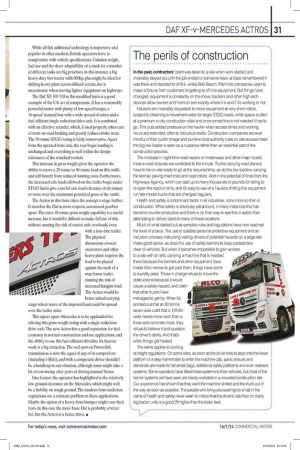The perils of construction
Page 27

If you've noticed an error in this article please click here to report it so we can fix it.
In the past, contractors' plant was taken to a site when work started and invariably stayed put until the job ended or someone back at base remembered it was there and decided to shift it, writes Bob Beech. Plant hire companies used to make a fortune from customers forgetting to off-hire equipment. But things have changed, equipment is constantly on the move, trackers and other high-tech devices allow owners and hirers to see exactly where it is and if it's working or not.
Hauliers are invariably requested to move equipment at very short notice, subject to obtaining a movement order for larger STGO loads, while space is often at a premium in city construction sites and once a machine is not needed it has to go. This puts added pressure on the haulier when access times and working hours are restricted, often to ridiculous levels. Construction companies are ever mindful of their public image and punitive local authority rules on site access mean the big low-loader is seen as a nuisance rather than an essential part of the construction process.
The increase in night-time road repairs on motorways and other major routes, means road closures are controlled to the minute. Trucks carrying road planers have to be on-site ready to go at the required time, as do the low-loaders carrying the tarmac paving machines and road-rollers. Add in the potential of fines from the Highways Agency, which can add up to many thousands of pounds for failing to re-open the road on time, and it's easy to see why hauliers shifting this equipment run late model trucks that are changed regularly.
Health and safety is a dominant factor in all industries, none more so than in construction. While safety is obviously paramount, in many instances this has become counter-productive and there is no finer way to see this in action than attempting to deliver plant to many of these locations. Much of what started out as sensible rules and regulations have now reached the level of a farce. The use of suitable personal protective equipment and an induction process instructing visiting drivers of potential hazards on a large site make good sense, as does the use of safety barriers to keep pedestrians clear of vehicles. But when it becomes impossible to gain access to a site with an artic carrying a machine that is needed there because the barriers and other equipment have made it too narrow to get past them, things have come to a pretty pass. Those in charge refuse tomove the obstructions because it would cause a safety hazard, and claim that other trucks have
managed to get by. When it's pointed out that an 80-tonne seven-axle outfit that is 12ft 6in wide needs more room than a three-axle concrete mixer, they refuse to believe it and question the driver's ability. And that's when things get heated. The same applies to working
at height regulations. On some sites, as soon as the driver tries to step onto the lower platform of a step-frame trailer to enter the machine cab, panic ensues and demands are made for fall arrest bags, additional safety platforms and even restraint systems. Some operators have fitted these systems to their vehicles, but most of the barrier systems we have seen are barely workable in a crowded construction site. Our experience has shown that they want the machine shifted and the truck out of the way as soon as possible. The people who bring proceedings to a halt in the name of health and safety never seem to notice that the driver's cab floor on many big tractor units is a good 2ft higher than the trailer bed.











































